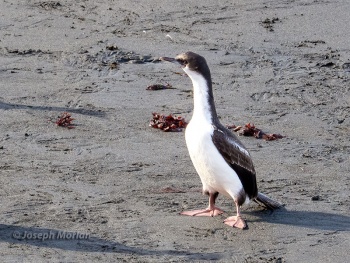Alternate names: South Georgia Blue-eyed Shag, South Georgia Cormorant
- Leucocarbo georgianus
Phalacrocorax georgianus
Identification
L 72 cm (28'), W 27cm (10.6")
Largish black and white, blue-eyed marine shag
Males are larger in most mensural data, particularly wing and tail lengths.
Breeding - Yellow knob (caruncle) over nostrils. Crest.
Nonbreeding - Lacks yellow knob. No crest.
Immature - Brown fringing on wing coverts. Pale forehead. White throat.
Similar Species
Smaller than the two closest living, similar species Imperial Shag and Antarctic Shag with a proportionally shorter bill. Has less white in the face than Antarctic Shag. Range does not overlap with either species.
Distribution
Restricted to South Georgia Islands, South Sandwich and South Orkney Islands.
Taxonomy
This is a monotypic species, which in the past has been included in Imperial Shag.[1] Sometimes placed in the genus Phalacrocorax.
Habitat
Breeds on Tussac grass slopes, building truncated cone shaped nests of dried kelp, grass and mud.
Behaviour
Lays 2-3 greyish or bluish eggs in Nov-Dec, incubated by both sexes for 28-31 days. Chicks continuosly brood for 12-15 days and leave the nest at two months and fledge at around 65 days.
References
- Clements, J. F., T. S. Schulenberg, M. J. Iliff, D. Roberson, T. A. Fredericks, B. L. Sullivan, and C. L. Wood. 2017. The eBird/Clements checklist of birds of the world: v2017, with updates to August 2017. Downloaded from http://www.birds.cornell.edu/clementschecklist/download/
- Alvaro Jaramillo. 2003. Birds of Chile. Princeton Field Guides. ISBN 0-691-11740-3
- Gómez Laich, A. (2012). Imperial Cormorant (Phalacrocorax atriceps), version 1.0. In Neotropical Birds Online (T. S. Schulenberg, Editor). Cornell Lab of Ornithology, Ithaca, NY, USA. https://doi.org/10.2173/nb.impcor1.01
- Orta, J., Garcia, E.F.J., Christie, D.A., Jutglar, F. & Kirwan, G.M. (2018). South Georgia Shag (Phalacrocorax georgianus). In: del Hoyo, J., Elliott, A., Sargatal, J., Christie, D.A. & de Juana, E. (eds.). Handbook of the Birds of the World Alive. Lynx Edicions, Barcelona. (retrieved from https://www.hbw.com/node/52651 on 6 June 2018).
- Shirihai, H. (2002) A Complete Guide to Antarctic Wildlife. The Birds and Marine Mammals of the Antarctic Continent and the Southern Ocean. Princeton University Press: Princeton & Oxford.
Recommended Citation
- BirdForum Opus contributors. (2024) South Georgia Shag. In: BirdForum, the forum for wild birds and birding. Retrieved 25 April 2024 from https://www.birdforum.net/opus/South_Georgia_Shag






